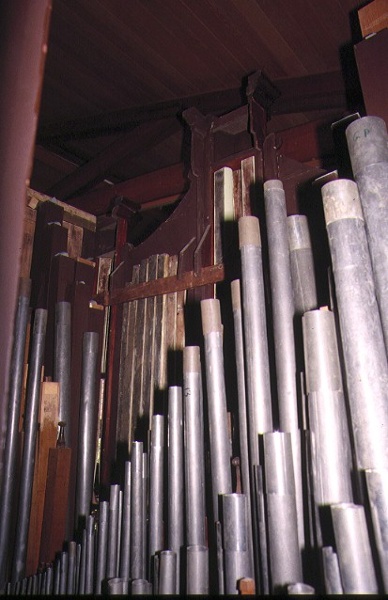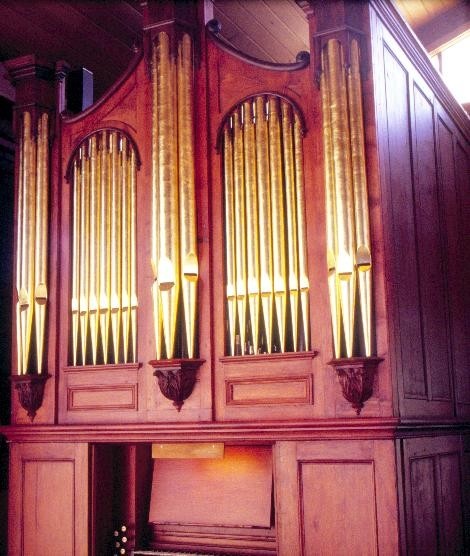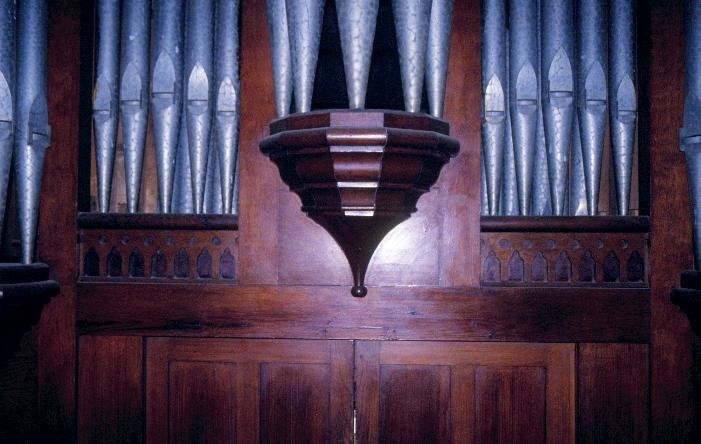PIPE ORGAN
OUR SAVIOUR LUTHERAN CHURCH, 646 BURWOOD HIGHWAY KNOXFIELD, KNOX CITY
-
Add to tour
You must log in to do that.
-
Share
-
Shortlist place
You must log in to do that.
- Download report




Statement of Significance
What is significant?
The pipe organ in Our Saviour Lutheran Church, Knox, was originally built in England at an unknown date. The casework is probably of early nineteenth century origin but its pipeworks are very old and are believed to date from the eighteenth century. It was installed in St Patrick's Roman Catholic Church in Melbourne in 1858 and moved to St Brigid's church in North Fitzroy in 1882. In 1886 it was re-built by renowned organ builder, Alfred Fuller and moved to the Congregational Church in Castlemaine. Following the closure of the Congregational Church around 1987, the organ was installed in Our Saviour Lutheran Church in Knox after a short time in storage.
How is it significant?
The pipe organ (Our Saviour Lutheran Church, Knox) is of scientific, aesthetic and historical significance to the state of Victoria.
Why is it significant?
The pipe organ (Our Saviour Lutheran Church, Knox) is of technical (scientific) significance as one of the few surviving two-manual instruments in Victoria from the mid-nineteenth century. The organ is important because it represents an epoch in organ building characterised by the transition from the late classical English organ to the early romantic English organ.
The pipe organ is aesthetically important for its overall design, which demonstrates a fine adaptation of an eighteenth century design consisting of three towers and two flats with neo-classical detailing. The organ's case represents a rare example of an early nineteenth century style of casework and its pipes are believed to be amongst the oldest surviving in Australia.
The pipe organ (Our Saviour Lutheran Church, Knox) is historically important for its associations with religious life in Victoria. In its recorded history in Victoria it has been associated with three different religious denominations. The organ is historically significant as the oldest in the state.
-
-
PIPE ORGAN - History
Associated People:
PIPE ORGAN - Permit Exemptions
General Exemptions:General exemptions apply to all places and objects included in the Victorian Heritage Register (VHR). General exemptions have been designed to allow everyday activities, maintenance and changes to your property, which don’t harm its cultural heritage significance, to proceed without the need to obtain approvals under the Heritage Act 2017.Places of worship: In some circumstances, you can alter a place of worship to accommodate religious practices without a permit, but you must notify the Executive Director of Heritage Victoria before you start the works or activities at least 20 business days before the works or activities are to commence.Subdivision/consolidation: Permit exemptions exist for some subdivisions and consolidations. If the subdivision or consolidation is in accordance with a planning permit granted under Part 4 of the Planning and Environment Act 1987 and the application for the planning permit was referred to the Executive Director of Heritage Victoria as a determining referral authority, a permit is not required.Specific exemptions may also apply to your registered place or object. If applicable, these are listed below. Specific exemptions are tailored to the conservation and management needs of an individual registered place or object and set out works and activities that are exempt from the requirements of a permit. Specific exemptions prevail if they conflict with general exemptions. Find out more about heritage permit exemptions here.Specific Exemptions:Nil
-
-
-
-
-
PIPE ORGAN
 Victorian Heritage Register H1280
Victorian Heritage Register H1280 -
Organ - Our Saviour Lutheran Church
 National Trust H1280
National Trust H1280
-
'Altona' Homestead (Formerly 'Laverton' Homestead) and Logan Reserve
 Hobsons Bay City
Hobsons Bay City
-
-











